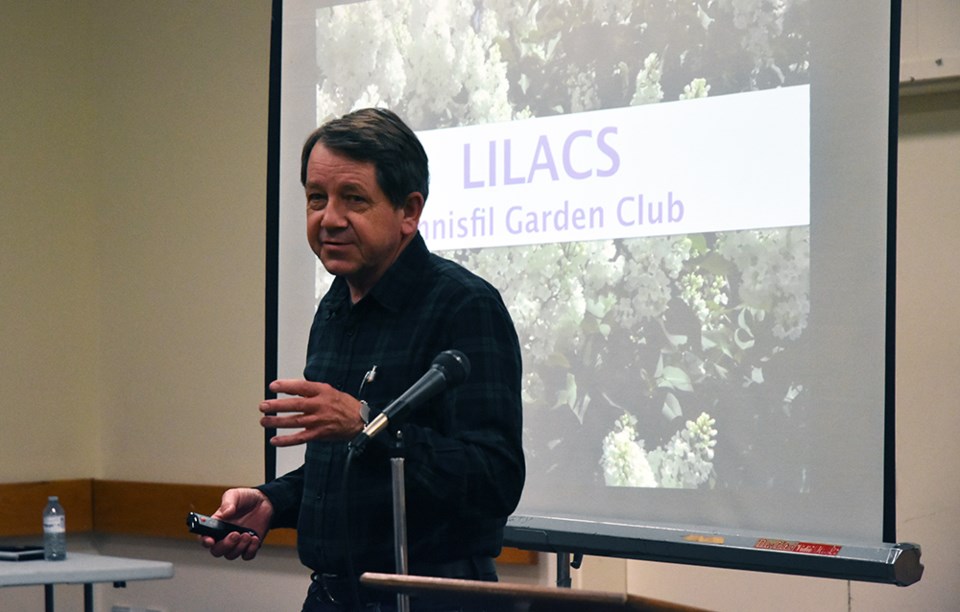As gardening expert Dugald Cameron noted, “Long after the farmhouse is gone, what is left is the lilac.”
The favourite shrub of the pioneers was hardy, easy to transplant and grow, it bloomed early in the spring, and it scented the air with its perfume, Cameron said at the Innisfil Garden Club Monday.
And it was incredibly tough, as long as it had good drainage and exposure to sun, which is why so many settlers planted lilacs around their homes and cabins.
Cameron, who formerly operated Gardenimports — a company specializing in quality bulbs and plants — has always been a lilac fan, and shared information on the shrub’s history, breeding and hybridization.
For enthusiasts, the Royal Botanical Gardens in Hamilton has “one of the largest collections of lilacs in the world,” Cameron noted, yet most nurseries and garden stores carry no more than 15 of the most common varietals.
“When you consider there’s more than 4,000, it’s kind of a shame,” he said, urging gardeners to do the research and ask their nurseries to supply some of the rarer, more interesting varieties.
A slideshow illustrated the range of growth patterns, from dwarf shrubs to towering trees, and colours — white, violet, purple, blue, pink, magenta — of the various strains.
Lilacs are mountain plants, which explains why they are so hardy, said Cameron. The most common, syringa vulgaris, was originally found in Romania.
“They were carried in pieces all over the world because people love lilacs, and they’re easy to carry,” he said.
From those humble roots, plant explorers and “plant nuts” searched Asia for new strains, and hybridized new varieties starting in the 1900s.
“In the Victorian era, there was a plant craze in Europe,” Cameron said, and enthusiasts like George Eastman, founder of Kodak, not only collected plants but bred them.
There was even some “Canadian content.” Frank Skinner, a Manitoba cattle farmer who was “kind of keen on plants” bred a range of early-blooming, extremely hardy lilacs, Cameron said.
Isabella Preston, who worked for Agriculture Canada in the 1920s, also came up with approximately 80 hybrids, few of which are currently available, he added.
Cameron shared images of his favourite lilacs, including new varieties like syringa bloomerang, which blooms throughout the year. He also provided sage advice on when and how to plant before touching on a taboo topic: pruning.
“Pruning is kind of like sex. You don’t want to talk about it,” he said, but pruning is necessary to revitalize lilacs and keep them blooming. He recommended pruning 30 per cent of the lilac shrub each year, after flowering and dead-heading (removing the finished blooms), starting with the oldest stems.
It’s the younger stems that are most vigorous and produce the flowers, Cameron said, providing some reassurance for hesitant gardeners: “Don’t worry. They are hard to kill.”
The May general meeting of the Innisfil Garden Club takes place on Monday, May 13 at the Churchill Community Centre, 7:30 p.m. Guest speaker is Master Gardener Dan Cooper, co-author of Gardening from a Hammock, on how to make your garden work for you.
And on May 25, the club hosts its annual Tailgate Sale, Plant Sale, Bake Sale and Barbecue at the South Innisfil Arboretum, at the corner of Shoreacres Drive and 20 Sideroad, from 8 a.m. to 1 p.m. To rent space in the Tailgate Sale, contact Lucy Valente at 705-716-5848. To contribute to the Bake Sale, contact Sharon Wice at 705-456-3316. To donate plants, contact Mona Rea at 705-456-3123.



